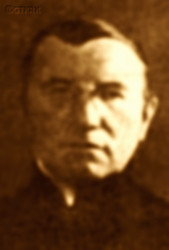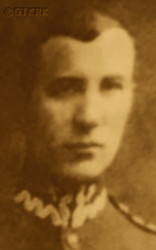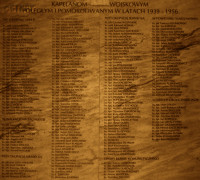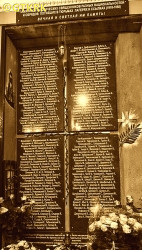Roman Catholic
St Sigismund parish
05-507 Słomczyn
85 Wiślana Str.
Konstancin deanery
Warsaw archdiocese, Poland
full list:
displayClick to display full list

searchClick to search full list by categories
wyświetlKliknij by wyświetlić pełną listę po polsku

szukajKliknij by przeszukać listę wg kategorii po polsku

Martyrology of the clergy — Poland
XX century (1914 – 1989)
personal data
surname
BORYSIUK
forename(s)
John Casimir (pl. Jan Kazimierz)
function
diocesan priest
creed
Latin (Roman Catholic) Church RCmore on
en.wikipedia.org
[access: 2014.09.21]
diocese / province
Pinsk diocesemore on
en.wikipedia.org
[access: 2013.05.19]
Kamianets diocesemore on
en.wikipedia.org
[access: 2013.05.23]
Lutsk‐Zhytomyr diocese (aeque principaliter)more on
www.catholic-hierarchy.org
[access: 2021.12.19]
RC Military Ordinariate of Polandmore on
en.wikipedia.org
[access: 2014.12.20]
honorary titles
Gold „Cross of Merit”more on
Gold „Cross of Merit”
(03.12.1938)
date and place
of death
1953

ITL OmLagGuLAG slave labour camp network
today: Omsk oblast, Russia
more on
old.memo.ru
[access: 2022.08.17]
details of death
While studying at the gymnsium in Brześć nad Bugiem (till c. 1906), a member of the clandestine Polish national and educational organization. Among others distributed the magazines „The Pole” and „Kiliński”, illegal in the Russian Empire, but smuggled from Kraków in the Austro–Hungarian Empire.
Before the outbreak of World War I, during ministry in Kamyanets‐Podilskyi, as a prefect, organized secret self–education circles and a library of Polish books among young people.
After the outbreak of the war, organised a conspiratorial military organization, many of whose participants, after the rebirth of the Polish state in 1918, voluntarily joined the Polish Army.
In 06.1920, joined the Polish Army withdrawing from 26.05.1920 from Kiev — earlier captured by the Polish troops, as part of the so‐called Kiev expedition, the first part of the Polish–Russian war 1919‐1921 — and left the Ushytsa parish. As a military chaplain, withdrew west with the 3rd Łódź Stage Battalion (performing guard and stage duties at the back of the front line).
Prob. stopped in Vinnytsia, where until 06‐07.1920 the Command of the Stages of the Polish Troops in Ukraine DEU was located. In 07.1920, assigned to field hospital No. 1011 of the 6th Polish Army. During the withdrawal — through Brzuchowice, Zimna Woda towards Lviv — due to the lack of a sufficient number of non‐commissioned officers, participated in the intelligence duties as a patrol commander. After the defeat of the invading Russian troops in the Battle of Warsaw on c. 15.08.1920 (known as „Miracle on the Vistula”), prob. together with the 6th Army and field hospital No. 1011 took part in the counterattack in the southern part of the front in Ukraine. The 6th Army began its attack on the positions of the Russian Rus. Первая Конная армия (Eng. 1st Horse Army) of Gen. Semyon Budyonny on 14.09.1920, advancing towards Brody and Januszpol (Yampil) and Tarnopol. Polish troops captured Januszpol on 21.09.1920, and Tarnopol on 18.09.1920. The Russians withdrew beyond the Zbruch River on 24.09.1920. In 1921, began his ministry in Brześć nad Bugiem, in the emerging diocese of Pinsk — to Ushytsa, which was not incorporated into Poland after the Treaty of Riga that ended the Polish–Russian war in 1921, never returned.
on 30.11.1925 transferred to the reserve of the Polish Army, being appointed reserve chaplain also in 1927 and 1929 (each time for a statutory period of 2 years).
After the end of hostilities of the World War II, started by German and Russian invasion of Poland in 09.1939, after commencement of another Russian occupation in 1944, arrested by the Russians in 1948 in Baranovitchi.
Jailed in Kamyanets‐Podilskyi prison.
There sentenced to 10 years in Russian slave labour concentration camps — Gulag.
Transported to ITL SibLag and next in 05.1950 to ITL OmLag concentration camp n. Omsk where perished.
cause of death
extermination
perpetrators
Russians
sites and events
ITL OmLagClick to display the description, ITL SibLagClick to display the description, GulagClick to display the description, Ribbentrop‐MolotovClick to display the description, Pius XI's encyclicalsClick to display the description, Polish‐Russian war of 1919‐1921Click to display the description
date and place
of birth
09.02.1888

Brestform.: Brest on Bug (1923‐1939), Brest‐Litovsk (till 1923)
today: Brest dist., Brest reg., Belarus
more on
en.wikipedia.org
[access: 2021.09.29]
alt. dates and places
of birth
27.01.1888
presbyter (holy orders)
ordination
03.06.1911

Zhytomyrtoday: Zhytomyr urban hrom., Zhytomyr rai., Zhytomyr obl., Ukraine
more on
en.wikipedia.org
[access: 2021.09.17]
positions held
c. 1933 – 1948
dean — Baranavichytoday: Baranavichy dist., Brest reg., Belarus
more on
en.wikipedia.org
[access: 2022.05.02] RC deanery
1933 – 1948
parish priest — Baranavichytoday: Baranavichy dist., Brest reg., Belarus
more on
en.wikipedia.org
[access: 2022.05.02] ⋄ Exaltation of the Holy Cross RC parish ⋄ Baranavichytoday: Baranavichy dist., Brest reg., Belarus
more on
en.wikipedia.org
[access: 2022.05.02] RC deanery — also: prefect at schools
1945 – 1947
vicar general — Pinsk RC diocese — covering the area of deaneries occupied by Russians, which in 1944 were directly annexed by the Russians into Commie–Nazi Russia (the rest of the dioceses found themselves in the Russian–controlled state of the Polish People's Republic prl)
1943 – 1944
administrator — Novaya Mishtoday: Novaya Mish ssov., Baranavichy dist., Brest reg., Belarus
more on
be.wikipedia.org
[access: 2023.01.18] ⋄ Transfiguration of the Lord RC parish ⋄ Baranavichytoday: Baranavichy dist., Brest reg., Belarus
more on
en.wikipedia.org
[access: 2022.05.02] RC deanery
c. 1933
dean — Lyakhavichytoday: Lyakhavichy dist., Brest reg., Belarus
more on
en.wikipedia.org
[access: 2020.12.11] RC deanery — acting („ad interim”), prob.
c. 1936
administrator — Baranavichytoday: Baranavichy dist., Brest reg., Belarus
more on
en.wikipedia.org
[access: 2022.05.02] ⋄ Our Lady the Queen of Polish Crown RC parish ⋄ Baranavichytoday: Baranavichy dist., Brest reg., Belarus
more on
en.wikipedia.org
[access: 2022.05.02] RC deanery — acting („ad interim”), church in construction
c. 1922 – c. 1933
prefect — Brest on Bugform.: Brest‐Litovsk /till 1923/
today: Brest, Brest dist., Brest reg., Belarus
more on
en.wikipedia.org
[access: 2021.09.29] ⋄ secondary schools ⋄ Exaltation of the Holy Cross RC parish ⋄ Brest on Bugform.: Brest‐Litovsk /till 1923/
today: Brest, Brest dist., Brest reg., Belarus
more on
en.wikipedia.org
[access: 2021.09.29] RC deanery — i.a. in Romuald Traugutt's State Gymnasium and Polish School Society's Gymnasium; also: from 1925 auxilliary chaplain of the Brest garrison of the Polish Army; chaplain of the troops of the Polish Scouting Association ZHP and units of the Polish Red Cross PCK
12.1921 – 30.11.1925
RC military chaplain — Brest on Bugform.: Brest‐Litovsk /till 1923/
today: Brest, Brest dist., Brest reg., Belarus
more on
en.wikipedia.org
[access: 2021.09.29] ⋄ 9th Military District Hospital, Corps District OK No. IX Brest on Bug, Polish Armed Forces — commissioned; ministering i.a. among soldiers of the 82nd Infantry Regiment and the 2nd Aerostatic Battalion of the 1st Aeronautical Regiment; by decree of the Chief of State of ‐03.05.1922, confirmed with seniority from 01.06.1919 and 15th place on the list of Roman Catholic military chaplains, in the rank of captain; by decree No. L. 3448 of the Commander‐in‐Chief of 16.12.1921, verified with seniority from 01.04.1920 and 15th place on the list of Roman Catholic military chaplains, in the rank of captain
1920 – 1921
RC military chaplain — Military Hospital No. 1011, 6th Army, Polish Armed Forces — by L. 2845 decree of the Commander‐in‐Chief of 14.04.1921, at the request of the Bishop's Curia of the Polish Army, demobilised from the Polish Army
1920
priest — Stara Ushytsiaform.: Ushytsia
today: Stara Ushytsia hrom., Kamyanets‐Podilskyi rai., Proskuriv/Khmelnytskyi obl., Ukraine
more on
en.wikipedia.org
[access: 2021.09.17] ⋄ Holy Trinity RC parish ⋄ Ushytsiadeanery name
today: Stara Ushytsia, Stara Ushytsia hrom., Kamyanets‐Podilskyi rai., Proskuriv/Khmelnytskyi obl., Ukraine
more on
en.wikipedia.org
[access: 2021.09.17] RC deanery — or: Nova Ushytsia, Transfiguration parish, in the same deanery
1919 – 1920
curatus/rector/expositus — Kupyntoday: Horodok urban hrom., Proskuriv/Khmelnytskyi rai., Proskuriv/Khmelnytskyi obl., Ukraine
more on
en.wikipedia.org
[access: 2021.09.17] ⋄ RC church ⋄ Horodokalso: Horodok‐Podilskyi
today: Horodok urban hrom., Proskuriv/Khmelnytskyi rai., Proskuriv/Khmelnytskyi obl., Ukraine
more on
en.wikipedia.org
[access: 2021.09.17], St Stanislav the Bishop and Martyr RC parish ⋄ Kamyanets‐Podilskyitoday: Kamyanets‐Podilskyi urban hrom., Kamyanets‐Podilskyi rai., Proskuriv/Khmelnytskyi obl., Ukraine
more on
en.wikipedia.org
[access: 2021.09.17] RC deanery
1911 – 1918
vicar — Kamyanets‐Podilskyitoday: Kamyanets‐Podilskyi urban hrom., Kamyanets‐Podilskyi rai., Proskuriv/Khmelnytskyi obl., Ukraine
more on
en.wikipedia.org
[access: 2021.09.17] ⋄ St Peter and St Paul the Apostles RC cathedral parish ⋄ Kamyanets‐Podilskyitoday: Kamyanets‐Podilskyi urban hrom., Kamyanets‐Podilskyi rai., Proskuriv/Khmelnytskyi obl., Ukraine
more on
en.wikipedia.org
[access: 2021.09.17] RC deanery — also: prefect of gymnasiums for boys and girls, two commerce secondary schools, a primary school, and during World War I, 1914‐1918, a prison chaplain
1911
vicar — Krasnetoday: Nove Misto hrom., Vinnytsia rai., Vinnytsia obl., Ukraine
more on
uk.wikipedia.org
[access: 2023.03.02] ⋄ St Joseph Spouse of the Blessed Virgin Mary RC parish ⋄ Yampiltoday: Yampil urban hrom., Mohyliv‐Podilskyi rai., Vinnytsia obl., Ukraine
more on
en.wikipedia.org
[access: 2021.09.17] RC deanery — also: prefect
1906 – 1911
student — Zhytomyrtoday: Zhytomyr urban hrom., Zhytomyr rai., Zhytomyr obl., Ukraine
more on
en.wikipedia.org
[access: 2021.09.17] ⋄ philosophy and theology, Theological Seminary
sites and events
descriptions
ITL OmLag: Russian Rus. Исправи́тельно‐Трудово́й Ла́герь (Eng. Corrective Labor Camp) ITL Rus. Омскстроя (Eng. Omstroya) — concentration and slave forced labor camp (within the Gulag complex) — with headquarters in the city of Omsk, in the Omsk Oblast. Founded on 20.05.1950. Prisoners, many of whom were Poles, worked as slaves in the construction of an oil refinery and a thermal power plant, an airport, military warehouses, a rail bridge over the Om River and many other infrastructural projects (such as power lines, residential, social and cultural buildings, brick factory, reinforced concrete and reinforced concrete products, car depot, city sewage system and sewage treatment plant, roads, cinder block factory, etc.), as well as at quarries in the village of Borove in the Kokshetau region (today in Kazakhstan). At its peak — till the death on 05.03.1953 of Russian socialist leader, Joseph Stalin — c. 30,000 prisoners were held there: e.g. 21,335 (01.01.1953); 28,646 (01.04.1953). Ceased to exist on 24.07.1953 — renamed to Omskiy ITL (Omskiy Lag). (more on: old.memo.ruClick to attempt to display webpage
[access: 2022.08.17], old.memo.ruClick to attempt to display webpage
[access: 2022.08.17])
ITL SibLag: Russian Rus. Исправи́тельно‐Трудово́й Ла́герь (Eng. Corrective Labor Camp) ITL Rus. Сибирский (Eng. Siberian) — concentration and slave forced labor camp (within the Gulag complex) — headquartered in Mariinsk in Kemerovo Oblast, where a central camp for invalids was also operational (moved twice to Novosibirsk, c. 350 km away). Founded in 1929. One of the largest — initially spread over large area from Omsk to Krasnoiarsk, as a matter of fact whole Western Siberian Plain, next subdivided and limited to Novosibirsk, Tomsk and Kemerovo oblasts. Up to 80,000 inmates were held in SibLag: e.g. 78,838 (01.01.1938); 77,919 (01.01.1942); 70,370 (01.04.1942). Prisoners slaved at railroad construction, forestry, carpentry and in coal mines, and other industrial branches (brick, clothing, leather and fur factories and plants). Closed down in c. 1960. (more on: tspace.library.utoronto.caClick to attempt to display webpage
[access: 2018.09.02], www.gulagmuseum.orgClick to attempt to display webpage
[access: 2014.05.09])
Gulag: The acronym Gulag comes from the Rus. Главное управление исправительно‐трудовых лагерей и колоний (Eng. Main Board of Correctional Labor Camps). The network of Russian concentration camps for slave labor was formally established by the decision of the highest Russian authorities on 27.06.1929. Control was taken over by the OGPU, the predecessor of the genocidal NKVD (from 1934) and the MGB (from 1946). Individual gulags (camps) were often established in remote, sparsely populated areas, where industrial or transport facilities important for the Russian state were built. They were modeled on the first „great construction of communism”, the White Sea‐Baltic Canal (1931‐1932), and Naftali Frenkel, of Jewish origin, is considered the creator of the system of using forced slave labor within the Gulag. He went down in history as the author of the principle „We have to squeeze everything out of the prisoner in the first three months — then nothing is there for us”. He was to be the creator, according to Alexander Solzhenitsyn, of the so‐called „Boiler system”, i.e. the dependence of food rations on working out a certain percentage of the norm. The term ZEK — prisoner — i.e. Rus. заключенный‐каналоармец (Eng. canal soldier) — was coined in the ITL BelBaltLag managed by him, and was adopted to mean a prisoner in Russian slave labor camps. Up to 12 mln prisoners were held in Gulag camps at one time, i.e. c. 5% of Russia's population. In his book „The Gulag Archipelago”, Solzhenitsyn estimated that c. 60 mln people were killed in the Gulag until 1956. Formally dissolved on 20.01.1960. (more on: en.wikipedia.orgClick to attempt to display webpage
[access: 2024.04.08])
Ribbentrop‐Molotov: Genocidal Russian‐German alliance pact between Russian leader Joseph Stalin and German leader Adolf Hitler signed on 23.08.1939 in Moscow by respective foreign ministers, Mr. Vyacheslav Molotov for Russia and Joachim von Ribbentrop for Germany. The pact sanctioned and was the direct cause of joint Russian and German invasion of Poland and the outbreak of the World War II in 09.1939. In a political sense, the pact was an attempt to restore the status quo ante before 1914, with one exception, namely the „commercial” exchange of the so‐called „Kingdom of Poland”, which in 1914 was part of the Russian Empire, fore Eastern Galicia (today's western Ukraine), in 1914 belonging to the Austro‐Hungarian Empire. Galicia, including Lviv, was to be taken over by the Russians, the „Kingdom of Poland” — under the name of the General Governorate — Germany. The resultant „war was one of the greatest calamities and dramas of humanity in history, for two atheistic and anti‐Christian ideologies — national and international socialism — rejected God and His fifth Decalogue commandment: Thou shall not kill!” (Abp Stanislav Gądecki, 01.09.2019). The decisions taken — backed up by the betrayal of the formal allies of Poland, France and Germany, which on 12.09.1939, at a joint conference in Abbeville, decided not to provide aid to attacked Poland and not to take military action against Germany (a clear breach of treaty obligations with Poland) — were on 28.09.1939 slightly altered and made more precise when a treaty on „German‐Russian boundaries and friendship” was agreed by the same murderous signatories. One of its findings was establishment of spheres of influence in Central and Eastern Europe and in consequence IV partition of Poland. In one of its secret annexes agreed, that: „the Signatories will not tolerate on its respective territories any Polish propaganda that affects the territory of the other Side. On their respective territories they will suppress all such propaganda and inform each other of the measures taken to accomplish it”. The agreements resulted in a series of meeting between two genocidal organization representing both sides — German Gestapo and Russian NKVD when coordination of efforts to exterminate Polish intelligentsia and Polish leading classes (in Germany called «Intelligenzaktion», in Russia took the form of Katyń massacres) where discussed. Resulted in deaths of hundreds of thousands of Polish intelligentsia, including thousands of priests presented here, and tens of millions of ordinary people,. The results of this Russian‐German pact lasted till 1989 and are still in evidence even today. (more on: en.wikipedia.orgClick to attempt to display webpage
[access: 2015.09.30])
Pius XI's encyclicals: Facing the creation of two totalitarian systems in Europe, which seemed to compete with each other, though there were more similarities than contradictions between them, Pope Pius XI issued in 03.1937 (within 5 days) two encyclicals. In the „Mit brennender Sorge” (Eng. „With Burning Concern”) published on 14.03.1938, condemned the national socialism prevailing in Germany. The Pope wrote: „Whoever, following the old Germanic‐pre‐Christian beliefs, puts various impersonal fate in the place of a personal God, denies the wisdom of God and Providence […], whoever exalts earthly values: race or nation, or state, or state system, representatives of state power or other fundamental values of human society, […] and makes them the highest standard of all values, including religious ones, and idolizes them, this one […] is far from true faith in God and from a worldview corresponding to such faith”. On 19.03.1937, published „Divini Redemptoris” (Eng. „Divine Redeemer”), in which criticized Russian communism, dialectical materialism and the class struggle theory. The Pope wrote: „Communism deprives man of freedom, and therefore the spiritual basis of all life norms. It deprives the human person of all his dignity and any moral support with which he could resist the onslaught of blind passions […] This is the new gospel that Bolshevik and godless communism preaches as a message of salvation and redemption of humanity”… Pius XI demanded that the established human law be subjected to the natural law of God , recommended the implementation of the ideal of a Christian state and society, and called on Catholics to resist. Two years later, National Socialist Germany and Communist Russia came together and started World War II. (more on: www.vatican.vaClick to attempt to display webpage
[access: 2023.05.28], www.vatican.vaClick to attempt to display webpage
[access: 2023.05.28])
Polish‐Russian war of 1919‐1921: War for independence of Poland and its borders. Poland regained independence in 1918 but had to fight for its borders with former imperial powers, in particular Russia. Russia planned to incite Bolshevik‐like revolutions in the Western Europe and thus invaded Poland. Russian invaders were defeated in 08.1920 in a battle called Warsaw battle („Vistula river miracle”, one of the 10 most important battles in history, according to some historians). Thanks to this victory Poland recaptured part of the lands lost during partitions of Poland in XVIII century, and Europe was saved from the genocidal Communism. (more on: en.wikipedia.orgClick to attempt to display webpage
[access: 2014.12.20])
sources
personal:
biographies.library.nd.eduClick to attempt to display webpage
[access: 2014.05.09], polesie.orgClick to attempt to display webpage
[access: 2015.09.30], kresy24.plClick to attempt to display webpage
[access: 2015.09.30], www.ordynariat.wp.mil.plClick to attempt to display webpage
[access: 2013.01.06], baranowicze.bloog.plClick to attempt to display webpage
[access: 2014.01.16], polesie.orgClick to attempt to display webpage
[access: 2023.11.24]
bibliographical:
„Lexicon of Polish clergy repressed in USSR in 1939‐1988”, Roman Dzwonkowski, SAC, ed. Science Society KUL, 2003, Lublin
original images:
polesie.orgClick to attempt to display webpage
[access: 2015.09.30], www.katedrapolowa.plClick to attempt to display webpage
[access: 2014.01.16], ipn.gov.plClick to attempt to display webpage
[access: 2019.02.02]
LETTER to CUSTODIAN/ADMINISTRATOR
If you have an Email client on your communicator/computer — such as Mozilla Thunderbird, Windows Mail or Microsoft Outlook, described at WikipediaPatrz:
en.wikipedia.org, among others — try the link below, please:
LETTER to CUSTODIAN/ADMINISTRATORClick and try to call your own Email client
If however you do not run such a client or the above link is not active please send an email to the Custodian/Administrator using your account — in your customary email/correspondence engine — at the following address:

giving the following as the subject:
MARTYROLOGY: BORYSIUK John Casimir
To return to the biography press below:
 Click to return to biography
Click to return to biography











